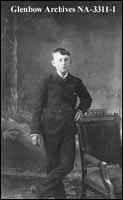Norwegian Settlers
 Norwegian settlers began arriving in Alberta around 1892, but they had been leaving their homeland long before. Crop failures, overpopulation, and economic crises had caused unemployment and
misery, and a dissatisfied class had arisen with less access to education and
other opportunities. In the nineteenth century, Norwegians had participated
heavily in religious and political endeavours - including the pietistic movement inaugurated by Hans Nilson
Hauge - which stressed adult education, political activism, and personal piety,
and which supported the
Lutheran church. Norway could not support these ideals on her own. And so, not without more hardship, Norwegian families crossed the ocean to North America, the "land of freedom." Norwegian settlers began arriving in Alberta around 1892, but they had been leaving their homeland long before. Crop failures, overpopulation, and economic crises had caused unemployment and
misery, and a dissatisfied class had arisen with less access to education and
other opportunities. In the nineteenth century, Norwegians had participated
heavily in religious and political endeavours - including the pietistic movement inaugurated by Hans Nilson
Hauge - which stressed adult education, political activism, and personal piety,
and which supported the
Lutheran church. Norway could not support these ideals on her own. And so, not without more hardship, Norwegian families crossed the ocean to North America, the "land of freedom."
The first attempts to attract and keep Norwegian settlers in eastern Canada was a failure. Despite the free land offered and the Norwegians’ willingness to move, the lack of proper roads and employment meant that most settlers moved from Newfoundland down to the States.
Edmund Thompson, one of the first Norwegian settlers to arrive in the west,
came to central Alberta in 1893, and persuaded many of his kinsmen to follow his example. He worked for many years as a land guide in the latter part of the 1890s, and actually guided the first residents of
Bardo, Alberta to their homestead in 1894. Evan and Ludvik Olstad, brothers from Norway, came to what was to become the village of
New Norway with other relatives and friends in 1892. In 1903, a large number of Norwegian settlers began settling in the areas around
Olds and Wetaskiwin.
In May of 1904, Ole Bakken built a small store with an upstairs dwelling near Stoney Creek, and by 1905, the new village of Sparling was beginning to form, with a harness shop, a hotel, and a "Stopping House."
In 1955, the name of Camrose, meaning, "a hill of roses," was approved.
Many other Norwegian settlers continued to come to Alberta throughout the early part of the twentieth century, and they were buying land to support their growing families. While, according the Census of Canada, there were only 304 Norwegians in the area in 1901, by 1911, there were 5,761 people in the province who had been born in Norway.
The CKUA Heritage Trails:
To listen to the Heritage Trails, you need the RealPlayer,
available free from RealNetworks:

- Scandinavian, Place Names: Armena and Bardo- How did the Alberta towns Armena and Bardo get their names? Hear the story of two of the first Scandinavian settlements in the province.
Read | Listen
- Scandinavian Place Names, Part Three: Oyen and Standard- The south-central part of Alberta has been a favourite of Scandinavian settlers since the early part of the twentieth century. Listen, and learn about the Norwegian Andrew family, and the towns of Oyen and Standard.
Read | Listen
- Scandinavian Place Names: Valhalla- Valhalla is the mythical home of Viking gods, but it was also the Alberta home of Scandinavian settlers led by Norwegian pastor
H.N. Ronning.
Read | Listen
|

|



